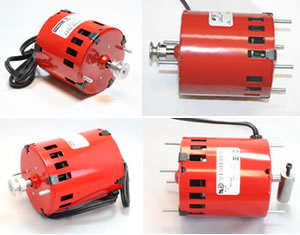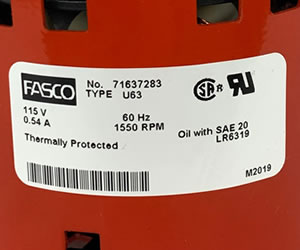My Rock Tumbler's Motor is Hot! Is That Normal?
Most motors will be hot to the touch when operating. Here are a few tips for safe operation.

Thermally protected motors for Thumler's Tumblers.
Top left: fits A-R1, A-R2, A-R12.
Top right: fits Model B (high speed).
Bottom right: fits UV-10 Industrial.
Bottom left: fits Model B (low speed).
We also sell replacement motors for a limited number of Lot-o-Tumbler and Lortone machines. If you need a motor for any other brand of tumbler, please contact the manufacturer of that tumbler.
Rock Tumbler Motors Run Hot
Many people who own a rock tumbler notice that the tumbler's motor is very warm - even hot - while the tumbler is operating. They are often concerned that something is wrong with their tumbler. We understand completely because we were surprised the first time we discovered that our tumbler's motor felt "hot to the touch".
Every rock tumbler that we own has an air-cooled motor that runs "hot to the touch". You can touch the motor with your finger without being burned, but if you allow your finger to remain in contact with the motor for more than a moment, the heat will be uncomfortable. That motor temperature is normal.
Thermally Protected Motors
High-quality rock tumblers have thermally protected motors. These motors are designed to shut off if they become overheated. This is a safety feature intended to prevent burns and fires.
We sell several Thumler's Tumblers that are shipped from the factory with thermally protected motors. They are the Thumler's A-R1, A-R2, A-R12, Model B, U-V10 Industrial Model, and U-V18 Industrial Model. We believe that these are some of the highest quality motors used in hobbyist rock tumblers today.

Thermally protected motors usually have the words "thermal protection" or "thermally protected" on the motor nameplate. Thermal protection is a safety feature and a feature that can extend motor life in some situations. Motor manufacturers want you to know if the motor is thermally protected - it is a sign of quality.
Our Experience with Hot Motors
We have been using Thumler's Tumblers since the 1960s and have sold thousands of their tumblers to customers. We have never heard of a fire or a building electrical problem being attributed to a Thumler's Tumbler. We have never heard of a fire or an electrical problem being attributed to a Lot-o-Tumbler (another brand of tumblers that we sell).
At almost any time, we have as many as six rock tumblers running at our office. This is a combination of Thumler's Tumblers, Lot-o-Tumblers, and Lortone tumblers. We estimate that the tumblers at our office have experienced a total running time of at least 60 years. Out of all of that time, we have only experienced a motor overheating to the point of shutting off on two occasions.
One overheating was on a Thumler's A-R2, when one of the barrels got wedged between the drive shaft and the idler shaft. That kept the drive shaft from turning, but the motor kept running and working hard trying to turn that stuck driveshaft. The motor overheated and shut down. We found the tumbler stopped that evening. The room had an odor of burned plastic. We had to replace the motor. It would no longer operate.
The second occurred with a Lortone QT12 tumbler. The lid on that tumbler popped off during operation because there was a build-up of gas in the barrel. The lid began rubbing against the frame of the tumbler and the resistance caused the motor to fail. Again, we had to replace the motor.
Take Care of Your Tumblers and They Will Serve You Well
We have had good luck with our tumbler motors. This good luck may be in part to three habits which we practice: 1) we keep our rock tumbling area clean and free of excess dust (which air-cooled motors inhale continuously), 2) we keep our tumblers clean, and, 3) oil all of our tumblers regularly These are things that everyone who runs a rock tumbler should do.
Things You Should Watch For
If a motor on a rock tumbler begins to overheat, you will likely smell it. Overheating motors often emit an odor of hot plastic, hot oil, or something burning. If you experience this odor, do not touch the tumbler. Instead check the outlet where the tumbler is plugged in.
If you see smoke coming from the outlet, or if the outlet plastic is deformed, or if the wall is hot, do not touch the plug. Instead, leave the building and contact someone who can help right away. Call 911 if you do not have immediate help from someone who is trained to evaluate this situation. (We have never experienced this situation and have never heard of it occurring with any of our customers.)
If you don't see smoke, deformed plastic, or feel heat around the outlet or the plug, then unplug the tumbler and allow it to cool. After it is cool, try plugging it back in and see if the motor will run. If it runs, then unplug it, use compressed air to blow the dust out of the inside of the motor, wipe the motor with a clean cloth, and lubricate the tumbler. Inspect your tumbler's bearings and rollers to make sure that they are in good condition - we have pages for most Thumler's Tumblers that sell replacement parts. Also, this is a good time to clean the area around the tumbler - your goal is to rid the area of dust that might be inhaled by the motor.
When you start using the tumbler again, keep a close watch on it to make sure that it is running normally. If it produces an odor or smoke, then we recommend replacing the motor. If your motor fails to run after plugging it in, then it definitely needs to be replaced.
Things That Can Cause Overheating
Here are some things that can cause your rock tumbler to overheat. Do your best to avoid them!
- Covering the tumbler with a box to reduce noise (a box over the tumbler will cut off the supply of the fresh air needed to cool the motor). Instead of covering the tumbler to reduce noise, lubricate the tumbler, following the instructions provided by the manufacturer.
- Operating the tumbler in a hot shed, in direct sunlight, or in another hot environment. We have heard from numerous customers who operated a tumbler in these conditions, and on a hot summer day they went to check the tumbler and it was not operating. Some of these customers had to replace the motor on their tumbler.
- An event that adds resistance to the motor (a barrel jumping off of the shafts and wedging between them will impede the turning of the motor and cause it to fail).
- Poor bearing maintenance (dirty bearings create friction and apply extra load on the motor). Keep your bearings lubricated, keep them clean, and replace them if they stop operating smoothly. This will reduce the level of stress on your motor.
- Overloading the barrel. This can occur by adding too much volume, but can also occur when high-specific-gravity materials such as hematite are tumbled. Overloading can also be caused by running a large barrel on a tiny tumbler that was not designed for the heavy load. An overloaded tumbler will overheat.
- A problem in the motor that causes it to seize up or fail to start turning (a dropped stone or a ceramic pellet that bounces into one of the motor vents will likely kill the motor).
- An accumulation of dust or dirt in or on the motor that prevents it from cooling properly. (Don't operate a tumbler in a dusty environment. Keep the tumbler and surrounding area swept clean. Air-cooled motors inhale incredible volumes of air every minute. Dust-filled motors are a fire hazard.) If your tumbler motor is dusty it can often be cleaned by blowing it out using a can of compressed air.
Any machine operated by electricity can be a fire hazard under the right conditions, many of which are listed above.
There is one situation that should concern you. If you detect a hot oil or burnt plastic odor coming from your motor, or see smoke, that is a time to unplug the motor. When it is cool, clean the motor with compressed air, make sure that the tumbler is clean and lubricated. If you are in doubt about operating the tumbler then contact the manufacturer. Be watchful for an odor that warns that one of your motors is overheating.
Be Concerned About Motor Safety
Here are some general tips to keep your rock tumbler operating safely. Some of them also prevent overheating.
- unplug the motor before doing maintenance or repair
- use a tumbler with a thermally protected motor
- take care of the cord, inspect it regularly, and repair if it is damaged
- keep pets and small children away from where a motor operates
- operate the tumbler according to the manufacturer's instructions
- locate it where it has access to plenty of fresh air
- locate it away from combustible materials
- locate it away from sources of heat
- operate it in a clean and uncluttered environment
- keep the motor clean and in good operating condition
- inspect and lubricate the motor and bearings according to instructions
- wear safety glasses during use, repairs, and maintenance
- don't wear jewelry, loose sleeves, or dangling hair when working near a tumbler
- if you have doubts about your motor, contact the manufacturer
- if you must replace a motor, obtain a replacement of the same make and model
- using GFCI receptacles can improve the safety of your work area
A safety-conscious person who does the above can reduce the risk of fire, reduce the risk of injury, and prolong the life of the tumbler.
Quality, Care, and Gentle Use
We advocate buying a quality tumbler, made by a company that has been in business for a long time.
Some manufacturers design and build with a goal of producing the lowest-cost item on the market. The most expensive part of most rock tumblers is the motor, and using a low-quality motor is a place where costs can be cut. You get what you pay for.
We also advocate "care and gentle use" of the items that you purchase. It does not matter if it is a rock tumbler, a car, or a toaster. Treat your machines with respect. Keep them clean. Lubricate them regularly. Doing these things will often enable you to enjoy your possessions for a much longer time.
Some Motor Trivia
Most modern homes have at least two to three dozen small air-cooled motors working in them every day. These motors are in furnaces, air conditioners, refrigerators, ceiling fans, space heaters, recliners, washing machines, dryers, waste disposals, ovens, microwaves, attic fans, hair dryers, garage door openers, pumps, toys, and more. Most people are surprised to learn how many motors are working in their home.
Motors in the home cause occasional fires. They are the small machines that we live with, so we should buy quality products, install them properly, operate them gently, and maintain them according to the manufacturer's instructions.
Happy Tumbling!
RockTumbler.com Authors
 |
Hobart M. King has decades of rock tumbling experience and writes most of the articles on RockTumbler.com. He has a PhD in geology and is a GIA graduate gemologist. He also writes the articles about rocks, minerals and gems on Geology.com. |

